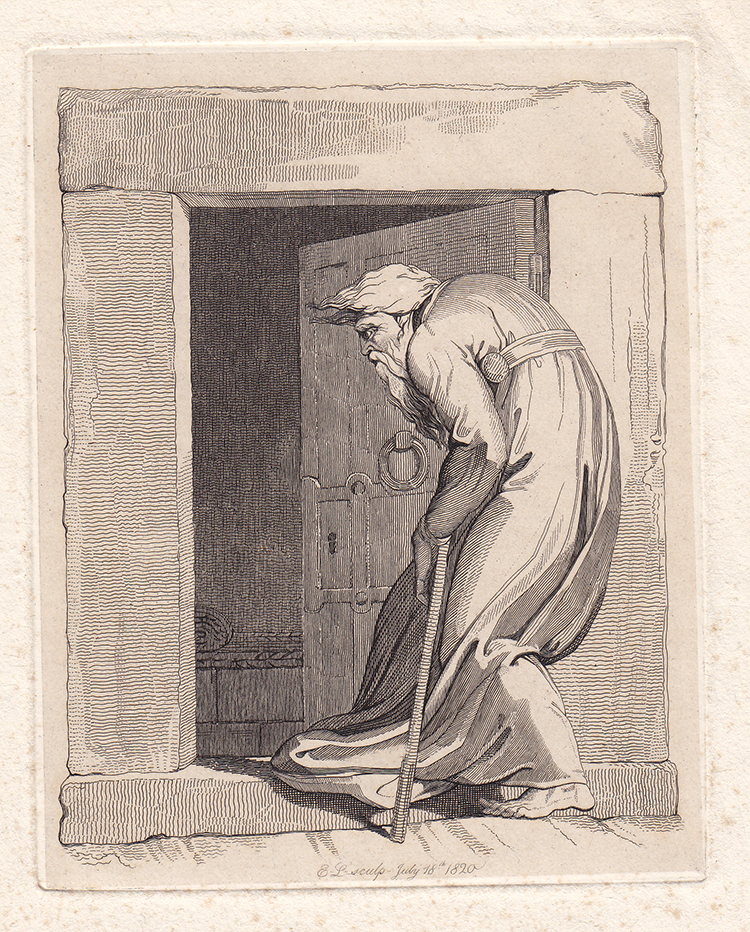
7. “Death’s Door,” an etched copy of Blake’s design. Inscribed in drypoint below the design, “E .. L .. sculp .. July 18th 1820” (the dot under the “t” of “th” is a paper stain, not a period). Image (including inscription) 14.1 x 10.7 cm., platemark 15.0 x 11.9 cm., on India paper laid onto a leaf of wove paper, 23.0 x 18.7 cm., without watermark. Essick collection.
This skilled etching is based on Louis Schiavonetti’s etching/engraving of “Death’s Door,” first published in R. H. Cromek’s 1808 ed. of Robert Blair’s The Grave and reprinted in R. Ackermann’s 1813 ed. of the poem. Much of the image follows Schiavonetti’s work line for line; only the shading below the threshold lower left is configured differently. The motifs in this etching are the same size as those in Schiavonetti’s pl., but the pl. reproduced here excludes the youth rising above the tomb, the rugged rocks surrounding its sides and top, and the plants lower right. A tracing of Schiavonetti’s pl. may have been transferred face down onto the etching ground for this close copy.
There are several reasons for believing that “E .. L ..” is the great Victorian animal painter Sir Edwin Henry Landseer (1802-73). He was a child prodigy in the arts, producing his first etching at age 7, exhibiting at the Royal Academy in 1815, and entering the R. A. schools a year later. In 1824, Landseer signed 2 of his etchings of animals, titled “The Beggar” and “The Common in Winter,” with his initials. In both, the 2 letters are connected, but the rounded shapes of the letters and their beginning and ending flourishes are similar to the initials in this “Death’s Door” etching. In his 1825 etching “Deerhounds’ Heads,” the initials are separate and close to the letter forms we see in “Death’s Door.” The etching style in the animal prints is freer and more expressive than in “Death’s Door,” but that is to be expected in compositions of an artist’s own invention rather than a reproductive work.
Landseer very probably learned to etch from his father, John George Landseer (1763/9-1852), a professional printmaker “who was extremely ambitious for his children” (ODNB) and instructed them in the arts. His Lectures on the Art of Engraving (1807) treats some of the same topics as Blake’s writings on that subject (see Essick, William Blake Printmaker [Princeton: Princeton UP, 1980] 198-99). Edwin was probably introduced to Blake’s Grave designs by his father. The “List of Subscribers” printed in the 1808 Grave includes “John Landseer, Esq. F. A. S. Engraver to the King” (2nd p. of the list, unpaginated). Thus, a copy of the book may well have been in the Landseer family home in 1820. John Landseer praises Schiavonetti in his 1807 Lectures (304-05) and, in his Descriptive, Explanatory, and Critical, Catalogue of Fifty of the Earliest Pictures Contained in the National Gallery of Great Britain (1834), alludes to Blake’s title-page design for The Grave (see Blake 44.4 [spring 2011]: 125). Perhaps copying “Death’s Door” was assigned to the son by the father as part of the young man’s training as an etcher.
Another possible source for Edwin Landseer’s knowledge about Blake is Henry Fuseli, keeper at the R. A. when Edwin attended its schools. He “attracted Fuseli’s attention by his talents and gentle manner” and was called “my little dog boy” by Fuseli; see Charles Robert Leslie, Autobiographical Recollections, ed. Tom Taylor (London: John Murray, 1860) 1: 39. According to Richard Ormond, Sir Edwin Landseer (London: Thames & Hudson, 1982) 43, Landseer “admired Henry Fuseli and William Blake.”
Information about Landseer given here is based on the biography in the ODNB by Judith Bronkhurst and Richard Ormond and on Frederick G. Stephens, Sir Edwin Landseer (London: Sampson Low, 1880). The latter includes reproductions of a few of Landseer’s early etchings. He is the only etcher/engraver with the initials E. L. and active c. 1820 listed in Raymond Lister, Prints and Printmaking: A Dictionary and Handbook of the Art in Nineteenth-Century Britain (London: Methuen, 1984). I am grateful to Alexander Gourlay for suggesting that this print may be by Landseer.